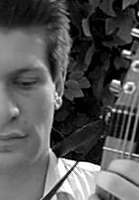A
biography
|
Born
in Haedo -a village in the west suburbs of Buenos Aires, full
of trees and silent afternoons- in 1969, the former guitar
player Diego Souto begun playing Chapman Stick in 1989, learning
basic rudiments from his teacher and friend Ricky Saenz Paz, who
was the first active Stick player in Argentina.
During
his early years as a Chapman Stick student, Diego recorded and
released various demo tapes, gaining publicity and creating spectation
from public and underground media:
|
|

|
|
| 1990 |
Catalogo
de atrocidades |
His
very first demo tape including four songs, produced by Ricky Saenz
Paz and featuring Stick, drum machines and keyboards. Style: could
be defined as Techno, with a glimpse into Soutoīs experimental
future.
|
| 1991 |
Catalogo
II |
The
original tracks from Catalogo... plus other songs, featuring Stick,
guitars, and several treated instruments. Style: The new tracks
are much more experimental than the ones included in the first
edition.
|
| 1992 |
Abisal
para consumidores |
An
extremely experimental piece of work, atonalism and poly rhythms,
featuring Stick, guitar and drum machines. Style: Somewhere between
King Crimson and Sex Pistols.
|
| 1993 |
Curriculum |
Revisited
versions plus a couple of new songs. |
| 1995 |
Stick
īnī Souto |
Intricate
patterns and over-loaded textures influenced by native argentine
rhythms. Featuring midi Stick, drum machines and voices. Style:
Electronic & argentine folkloric.
|
|
|
None
of these demo tapes is available anymore, but some of their
songs appeared revisited in the compilation album Lo
que queda en pie , which was released in 1999.
In
1995, after releasing his last demo tape StickīnīSouto
and doing several solo performances in rock & jazz clubs and
theaters in Buenos Aires and La Plata, Diego met the drummer
Fernando Juarez and formed the rock band Domo, lately
called Ars
Cottolengo. This band played during one year in night clubs
and released a single tape with two songs: Te azul and
Ars Cottolengo, now included in Lo
que queda en pie.
|
|

|
 |
|
The
same year, during a Guitar Craft seminar, the bizarre string ensemble
El Corno
del Fanyulo was born -or defecated by Muse and fell into
our ears, as one of its members said once- at the middle of
a strange improvisation whose participants were Luis Cagnolo,
Gustavo Villaverde and Diego. Afterwards they were joined by many
other guitarists, who used to come and go from the band as they
pleased.This ensemble never ceased to exist, but they were never
able to rehearse again after 1998. As a testimony of their craziness,
Diego took the role of an unusual Dee-Jay and produced Diga
Guisky, a very strange album with ten songs ensembled from
lots of improvisations and unfinished ideas.
|
From
1999 on, Diego begun performing in South America in order to present
his solo works: Words
of Fire. , Amniotic
eyes 1.5, and the newest Amniotic
eyes 2.0.
One
of these tours -specifically a series of performances in TerraVista,
a caffe/ theather/ showroom in Porto Alegre, Brazil- gave room to the
shared idea of developing a co-operative label with other experimental
bands and artists from Brazil and Argentina -called originally Parasito
and then Parasito de Luz-
in order to release all their works in small numbered editions.
 |
|
Once
the label was stabilised, he begun producing other bands, like
the experimental dance project AureliA
X. Also he supports music exchange between Argentina
and Brazil, like the tour of the band Iconoclasticos in Buenos
Aires during 2000, whose appropiate conclusion was a shared performance
in Porto Alegre, Brazil.
His
performances use to get image and music together: these are usually
complemented by the film maker/painter/musician Ugo Adam doing
slide shows at stage, with pictures by him and Diego itself.
|
Chapman
Stick and The Stick are trademarks of Stick Enterprises Inc. California
|



